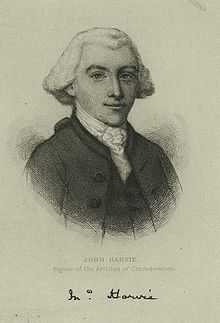John Harvie
| John Harvie | |
|---|---|
 | |
| Albert Rosenthal etching of Harvie | |
| Secretary of the Commonwealth of Virginia | |
| In office 1788–1789 | |
| Mayor of Richmond, Virginia | |
| In office 1785–1786 | |
| Preceded by | Robert Mitchell |
| Succeeded by | William Pennock |
| Delegate to the Continental Congress | |
| In office 1777–1778 | |
| Member of the Virginia conventions | |
| In office 1775–1776 | |
| Personal details | |
| Born | 1742 Albemarle County, Virginia |
| Died | February 6, 1807 Richmond, Virginia |
| Profession | Lawyer, Statesman |
John Harvie (1742 – February 6, 1807) was an American lawyer and builder from Virginia. He was a delegate to the Second Continental Congress in 1777 and 1778, where he signed the Articles of Confederation.
Early life and family
John Harvie was born in Albemarle County, Virginia, in 1742, to farmer and Scottish immigrant Col. John Harvie, Sr. (1706–1767) and Martha Gaines Harvie (1719–1802). His brother Richard was an older brother who resided in what is off US 60 in Amherst County now, of five children. As a boy, Harvie was a close friend of Thomas Jefferson, and his father became Jefferson's legal guardian after his cousin Peter Jefferson died in 1757. John read law and was admitted to the bar before settling in Augusta County.
Career
Harvie built a successful law practice. He married Margaret Morton Jones, daughter of Gabriel Jones and his wife Margaret Strother Morton, in Albermarle Co., Virginia, and they raised a large family.
In 1774 he was named as a commissioner to the Shawnee tribe to negotiate a peace treaty after the Battle of Point Pleasant. Augusta County sent him to the Virginia conventions (the revolutionary legislature) in 1775 and 1776. The following year that body sent him as a delegate to the Second Continental Congress.[1] While at the Continental Congress, Harvie was one of five Virginia delegates to sign the of, on July 9, 1778.[2]
During the rest of the Revolution, Harvie received the provisional rank of colonel, serving as a purchasing agent and supply organizer for Virginia's militia and Continental Army units. In 1780, he moved to Richmond, Virginia and began work as a land developer and builder. From 1785 to 1786, Harvie served as the fourth mayor of Richmond.
He was chosen as an elector for the 1789 election from Henrico District.[3] That District consisted of Charles City County, Goochland County, Henrico County, James City County, Louisa County, and New Kent County, which cover the area east and west of Richmond.[4][5] All of the ten electors from Virginia who voted cast one of their two votes for George Washington. Five of them cast their other vote for John Adams; three cast theirs for George Clinton; one cast his for John Hancock; and one cast his for Jay.[6]
Death
Harvie built a number of buildings in Richmond and public works in the area. While he was inspecting one of these sites (the Gamble House) on February 6, 1807 he died from an accidental fall from a ladder on the roof. He was buried at the family plot, at his home. This property later became part of the Hollywood Cemetery in Richmond.[7]
See also
References
- ↑ "Harvie - Biographical Information". Retrieved February 21, 2012. Biographical entry at the Biographical Directory of the United States Congress.
- ↑ Elliot, Jonathan (1836). The debates in the several state conventions on the adoption of the Federal constitution, as recommended by the general convention at Philadelphia in 1787, Vol I. Editor on the Pennsylvania Avenue. Retrieved February 21, 2012. pp. 98, 113. The other four were Richard Henry Lee, Banister (lawyer), Thomas Adams (politician), and Francis Lightfoot Lee.
- ↑ DenBoer, Gordon (1984). The Documentary history of the first Federal elections, 1788-1790, Volume 2. University of Wisconsin Press. page 303
- ↑ DenBoer, Gordon (1984). The Documentary history of the first Federal elections, 1788-1790, Volume 2. University of Wisconsin Press. page 306
- ↑ "Virginia 1789 Electoral College, District 2". Retrieved February 21, 2012.
- ↑ DenBoer, Gordon (1984). The Documentary history of the first Federal elections, 1788-1790, Volume 2. University of Wisconsin Press. pages 304–5
- ↑ "Hollywood Cemetery - History". Retrieved 21 February 2012.
